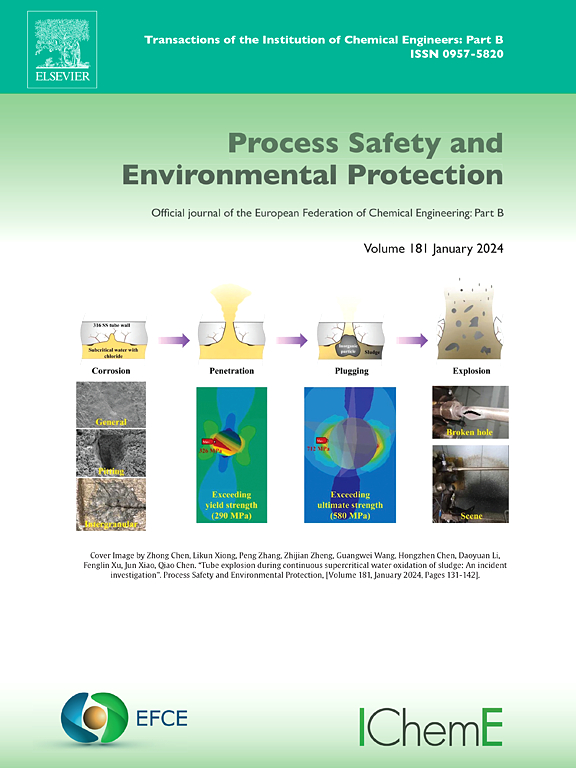4E(能源,能源,环境和经济)评价沼气净化与热电联产结合使用胺和离子液体
IF 6.9
2区 环境科学与生态学
Q1 ENGINEERING, CHEMICAL
引用次数: 0
摘要
利用1-丁基-4-甲基咪唑乙酸酯([BmimAc])与胺类溶剂-甲基二乙醇胺(MDEA)、2-氨基-2-甲基-1-丙醇(AMP)和二异丙胺(DIPA)联合制备高纯度生物甲烷(≥99 wt%),同时最大限度地提高工艺效率。该系统将沼气升级与热电联产(CHP)技术相结合,满足了能源需求,并产生了可持续电力。1-丁基-4-甲基咪唑醋酸盐+ 2-氨基-2-甲基-1-丙醇[BmimAc+AMP]体系表现最佳。虽然[BmimAc+DIPA]系统具有较低的能耗,但它面临着离子液体损失等挑战。火用分析表明,[BmimAc+AMP]系统通过减少火用破坏,最大限度地减少了能源浪费,从而实现了更高效的过程,同时降低了火用破坏系数。在环境方面,该系统由于其更高的效率也显著减少了碳排放。从经济上讲,[BmimAc+AMP]系统是最具成本效益的,使其成为沼气升级和热电联产的最经济实惠的选择。虽然这种方法显示出很大的希望,但离子液体损失和大规模应用的扩展等挑战仍有待解决。本文章由计算机程序翻译,如有差异,请以英文原文为准。
4E’s (Energy, Exergy, Environment, and Economic) evaluation of biogas purification integrated with CHP using amine & ionic liquids
The use of 1-butyl-4-methylimidazolium acetate ([BmimAc]) combined with amine solvents—methyl diethanolamine (MDEA), 2-amino-2-methyl-1-propanol (AMP), and diisopropylamine (DIPA)—was investigated to produce high-purity biomethane (≥ 99 wt%) while maximizing process efficiency. Integrating biogas upgrading with combined heat and power (CHP) technology, the system met energy demands and generated sustainable electricity. The1-butyl-4-methylimidazolium acetate + 2-amino-2-methyl-1-propanol [BmimAc+AMP] system emerged as the best performer. While the [BmimAc+DIPA] system had lower energy consumption, it faced challenges such as ionic liquid loss. Exergy analysis revealed that the [BmimAc+AMP] system minimized energy waste by reducing exergy destruction, leading to a more efficient process with a low exergy destruction factor. Environmentally, this system also significantly reduced carbon emissions due to its higher efficiency. Economically, the [BmimAc+AMP] system was the most cost-effective, making it the most affordable option for biogas upgrading and CHP generation. While this approach showed great promise, challenges such as ionic liquid loss and scaling up for large-scale applications remain to be addressed.
求助全文
通过发布文献求助,成功后即可免费获取论文全文。
去求助
来源期刊

Process Safety and Environmental Protection
环境科学-工程:化工
CiteScore
11.40
自引率
15.40%
发文量
929
审稿时长
8.0 months
期刊介绍:
The Process Safety and Environmental Protection (PSEP) journal is a leading international publication that focuses on the publication of high-quality, original research papers in the field of engineering, specifically those related to the safety of industrial processes and environmental protection. The journal encourages submissions that present new developments in safety and environmental aspects, particularly those that show how research findings can be applied in process engineering design and practice.
PSEP is particularly interested in research that brings fresh perspectives to established engineering principles, identifies unsolved problems, or suggests directions for future research. The journal also values contributions that push the boundaries of traditional engineering and welcomes multidisciplinary papers.
PSEP's articles are abstracted and indexed by a range of databases and services, which helps to ensure that the journal's research is accessible and recognized in the academic and professional communities. These databases include ANTE, Chemical Abstracts, Chemical Hazards in Industry, Current Contents, Elsevier Engineering Information database, Pascal Francis, Web of Science, Scopus, Engineering Information Database EnCompass LIT (Elsevier), and INSPEC. This wide coverage facilitates the dissemination of the journal's content to a global audience interested in process safety and environmental engineering.
 求助内容:
求助内容: 应助结果提醒方式:
应助结果提醒方式:


